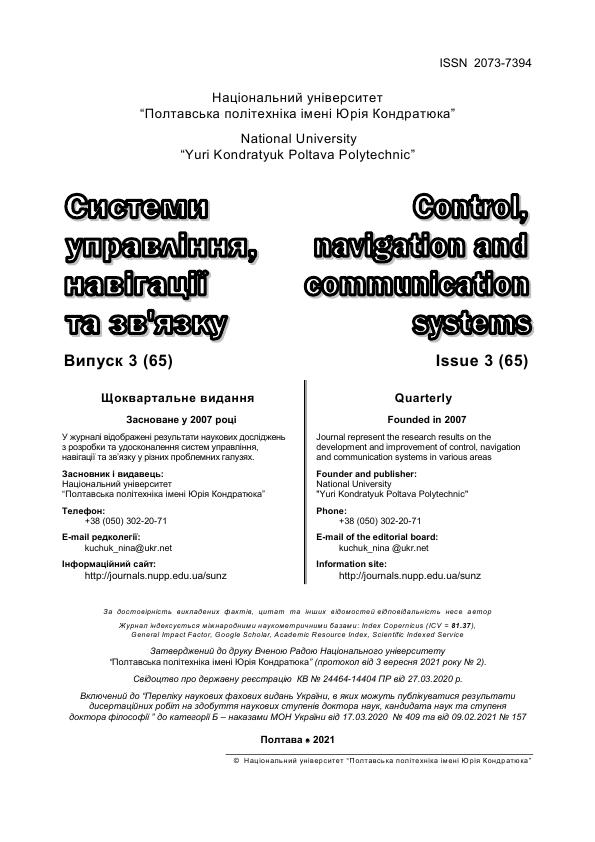JUSTIFICATION OF BASIC TECHNICAL REQUIREMENTS FOR MEANS OF CLEARING RADIO-CONTROLLED AMMUNITION
DOI:
https://doi.org/10.26906/SUNZ.2021.3.130Keywords:
anti-terrorist operation, radio-controlled ammunition, functional damage to radio equipmentAbstract
The possibilities of using ultra-wideband signals for the functional destruction of radio-controlled ammunition for electronic protection of personnel of NSU subdivisions are analyzed. It is shown that the most promising are discretecontinuous systems that use a combined capacitive energy storage using Arkadyev-Marx pulse voltage generators and an antenna system matched to it, which makes it possible to emit high-intensity electromagnetic pulses. The energy and spatial characteristics of the antenna system of the means of functional destruction of radio-controlled ammunition are estimated. It is established that when setting up a barrier NSC obstacle at a distance of 20 meters, it is necessary to have an energy potential of 220 kW, taking into account the loss of propagation along the Earth's surface. To reduce the mass and dimensions of the transmitter, it is proposed to use a pointed antenna system. It is proposed to use a sequence of 10 ultra-wideband signals, the period of passage of which is Тп = 10 m / s. The generated sequence will have a duration = 100. It is shown that at the width of the peak DS of the mirror antenna 80, at the range of the means of functional destruction of radio-controlled ammunition 20 meters, the width of the damage zone formed by the antenna pattern is 16 metersDownloads
References
Шифрин Я.С. Антенны: Учеб. Пособие / Я.С. Шифрин. Х.: ВИРТА, 1976. 407 с.
Власик С.Н. Оценка энергетических и пространственных характеристик сверхширокополосной РТС для постановки заградительных помех / Г.В. Ермаков, С.Н. Власик // Системи обробки інформації: Зб. наук. пр. – Х.: ХУПС. – 2009. − Вип. 6 (80). – С. 43–48
Власик С.Н. Методика определения диаграммы направленности сверхширокополосной зеркальной антенны с учетом взаимного влияния облучателя и рефлектора / М.Г. Иванец, Г.В. Ермаков, В.В. Воинов, С.Н. Власик // Зб. наук. пр. Хар. ун-ту Повітряних Сил. – Х.: ХУПС. – 2009. – Вип. 1 (19). – С. 39–41.
Хабаров В.Б. Еще раз о перспективах развития радиоуправляемых взрывных устройств и способов борьбы с ними / В.Б. Хабаров // Специальная техника. – 2004. – No 1. – С. 16–24.
Седышев Ю.Н. Приемные устройства радиолокационных сигналов / Ю.Н. Седышев, Л.К. Никонов, И.В. Васильев, В.И. Гапон. – М.: Воениздат, 1978. – Ч. 1. – 328 с
Черный Ф.Б. Распространение радиоволн. М,: Сов. радио, 1972. – 464 с.
Сахаров К.Ю. Исследование функционирования персональных компьютеров в условиях воздействия сверхкоротких ЭМИ / К.Ю. Сахаров, О.В. Михеев, В.А. Туркин // Технологии ЭМС. 2006. No 2 С. 44–49.
Титов С.В. Применение пространственно-фазово-частотного фокусирования плоской ФАР для функционального поражения радиотехнических средств короткими импульсами / С.В. Титов // Зб. наук. пр. Харків. ун-ту Повітряних Сил. 2003. No 1(44). С. 97–101.
Vlasik S.N. Estimation power and spatial characteristics of ultrawideband radar for statement of protecting handicaps / S.N. Vlasik, G.V. Yermakov, I.I. Zima // Материалы 5-й науч.-техн. конф. ["Ultrawideband аnd Ultrashort іmpulse Signal"]: М-во образования и науки Украины, Сев. нац. техн. ун-т. – Севастополь: СевНТУ, 2008. – 92 с
Власик С.Н. Определение мощности сверхширокополосной непреднамеренной помехи на входе приемника системы связи / С.Н. Власик, Г.В. Ермаков // Системи управління, навігації та зв'язку. – К.: ЦНДІ НУ. – 2010. – Вип. 2 (14). – С. 44–48.
Магда И.И. Стендовая база для испытаний радиоэлектронной аппаратуры на электромагнитную совместимость и стойкость к излучениям сверхкороткой длительности // 3-й Межд. радиоэлектронный форум «Прикладная радиоэлектроника. Состояние и перспективы развития» МРФ-2008: Сб. науч. тр. Том VI. – Х.: АНПРЭ, ХНУРЭ. – 2008. – С.7–11.




